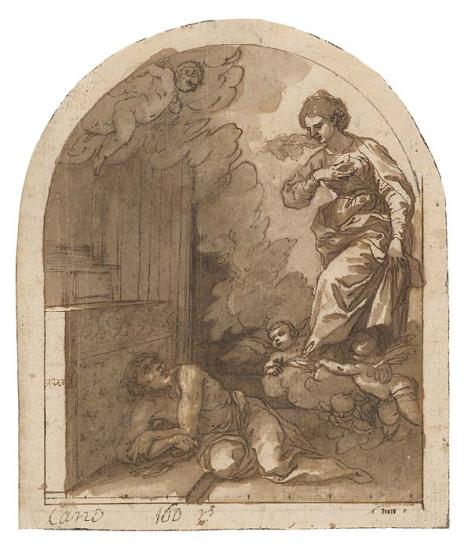
Virgin Appearing to a Man
Inscribed at lower left, Cano / 160 rs.
Purchased by Pierpont Morgan, 1909
A FLAGELLANT'S VISION
In contrast to Cano's monumental altarpiece design, exhibited nearby, this minute drawing with an arched top depicts the Lactating Virgin appearing to a flagellant who may personify the Christian soul. Before executing the figures, Cano meticulously planned the composition by including scale markings with 7-millimeter intervals at the bottom of the page. Although the iconography is difficult to interpret, the flagellant, lying before an altar, is startled by the vision engendered by his prayer and physical punishment. The viewer can contemplate two images: the flagellant who is experiencing the vision and the vision itself.
From the sixteenth to nineteenth centuries, Spain witnessed the rise of the Catholic Church along with the flourishing of court artists who explored deeply spiritual visions. Concurrently, the nightmare of the Inquisition drove artists to probe the darker side of human nature through scenes of martyrdom and torture. Drawing played a central role in their conception of these diverse subjects—from Murillo's preparatory studies for painting commissions to Goya's private albums satirizing contemporary society. In addition to this rich tradition in Spain, Spanish artists also worked abroad, notably in Naples, which was a Spanish territory.
Visions and Nightmares marks the first exhibition of Spanish drawings at the Morgan, whose holdings in this area are small but significant. Showcasing over twenty sheets by Spanish artists spanning four centuries, this selection traces the shifting roles and attitudes toward the art of drawing in Spain.
This online exhibition was created in conjunction with the exhibition Visions and Nightmares: Four Centuries of Spanish Drawings, on view January 17 through May 11, 2014 and organized by Edward Payne, Moore Curatorial Fellow.
This exhibition is made possible by the A. Woodner Fund.
